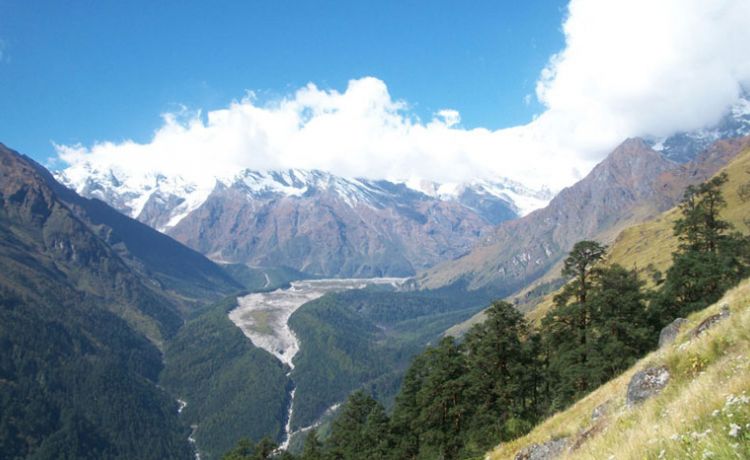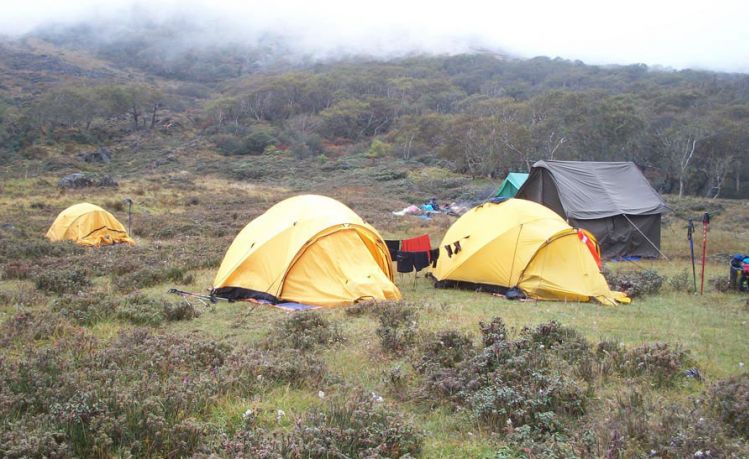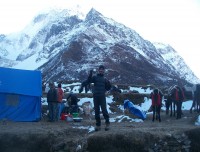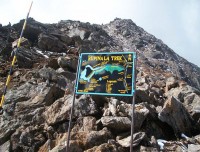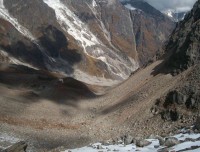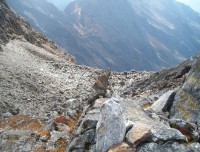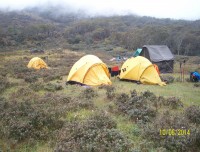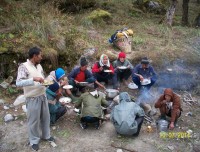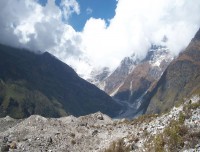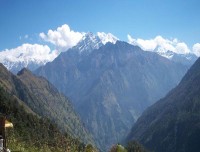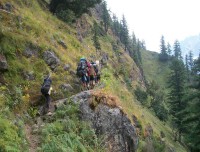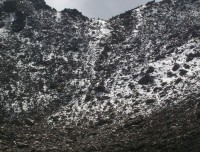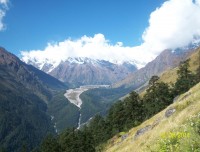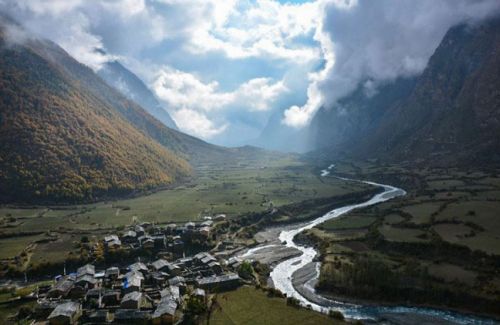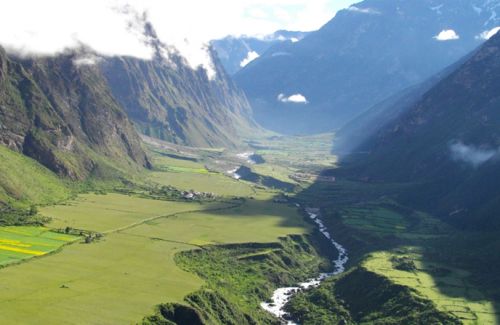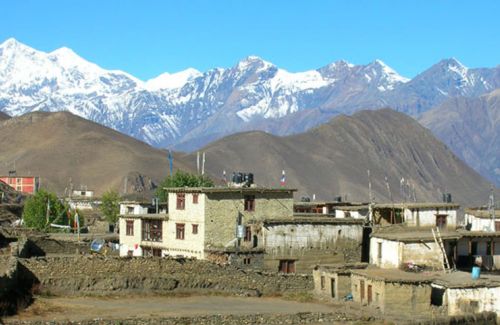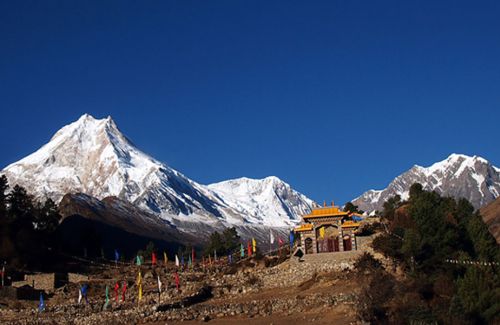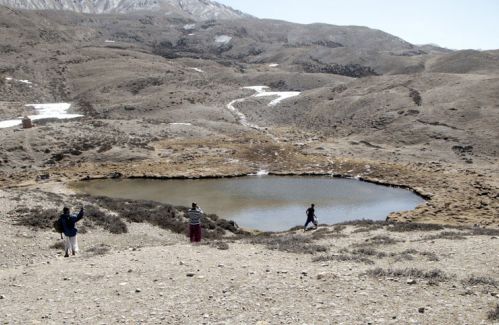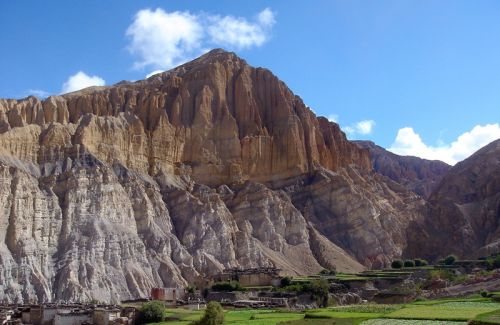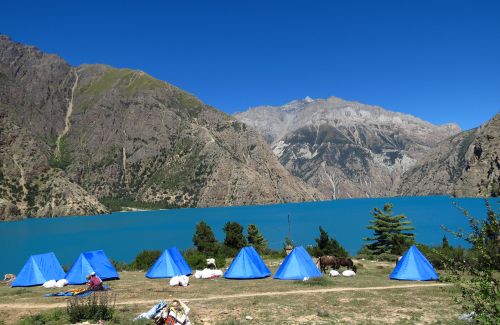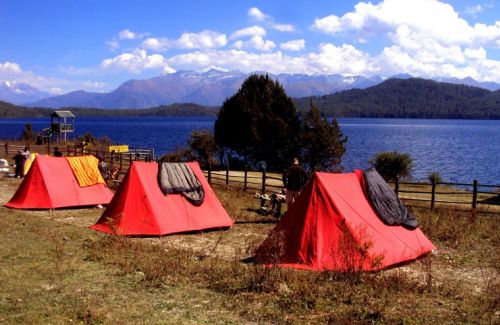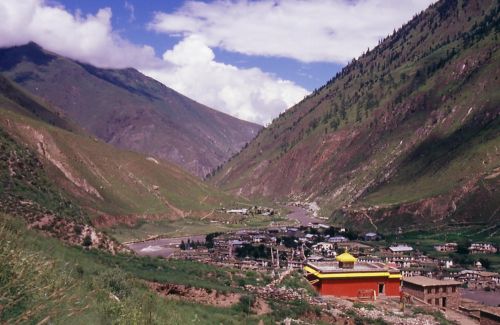Rupina La Pass Trekking
- Duration19 Days
- Max. Altitude4,610 m
- Starts FromUSD 2150
Destination:Nepal
Trip Grade:Challenging (*****)
Meals:Breakfast + Lunch + Dinner
Transportation:Private Vehicle/Tourist Bus
Accommodation:Camping
Trekking Region:Manaslu Region
Show AllRupina La lies in the Manaslu Region in the Gorkha District. This is strenuous trek because of difficult pass. Rupina La Pass is in lower part of Manaslu which offers the scintillating views of Manaslu (8,163 m), Himal Chuli (7,893 m), Boudha Himal (6,672 m), Peak 29 (7,871 m), Ganesh Himal ranges, and Langtang Himal ranges. Rupina La Pass Trekking is culturally rich with Tibetan influence. We trek to Rupina La along with Larkya La Pass. This is difficult pass not because of its high altitude but many trekkers lose their trail. This is the hidden part of the Manaslu Region. This trek was opened by the government of Nepal officially from 1991. There are no lodge accommodations available in this region. So, we have to do the camping trek in this region.
Rupina La Trek begins driving from Kathmandu to Gorkha, the historical place. It takes about 6 hours by bus then we reach to Dharchey via Thala and meet the Manaslu Circuit trek at Nyak. There is the other way following the Daraundi Khola too. As we continue to trek, we reach to Rupina La Phedi and cross the Rupina La Pass. After this, we descend to Jagat and eventually end our trek at Aarughat Bazaar of Gorkha District. There are many alternatives to do Trek Rupina La including Tsum Valley, going through Beshishahar and so on. Rupina La Pass trek gives us unique rural experience to the unexplored Himalayan scenery of northern part of Gorkha along with well preserved traditional norms and values. Anyone who is physically fit and fine would like to do adventurous trek once in a life time should do the trek Rupina La Pass.
Trip Highlights
- Sightseeing at World Heritage Sites in Kathmandu
- Scenic drive from Kathmandu to Gorkha
- Explore the typical countryside with many ethnic groups
- Visit Gorkha Palace and Gorakh Kali temple
- The place where the Gorakhnath Baba Meditated
- The historical place, the seat of Shah Dynasty
- The lush green valley view from the top of Dorakhkali
- Discover the Tibetan influence in this region
- A sweeping view of Manaslu, Hiunchuli, Boudha Himal, Peak 29 etc
- Cross over the Larkya La Pass ( 5,106 m)
Day to Day Itinerary
Day 01:Arrival in Kathmandu (1,350 m) & Transfer to Hotel. Overnight at Hotel
Day 02:Kathmandu Valley Sightseeing and Trek Preparation. O/N at Hotel
Day 03:Drive from Kathmandu to Gorkha (1,060 m) 5-6 hrs. Trek to Kalikasthan (1,520 m). O/N at Tented Camp
Day 04:Trek from Kalikasthan to Gairichap (1,420 m), 6 hrs. O/N at Tented Camp
Day 05:Trek from Gairichap to Thala (2,215 m), 6 hrs. O/N at Tented Camp
Day 06:Trek from Thala to Dharchey Dada (3,245 m) and to Shambe (2,930 m), 6 hrs. O/N at Tented Camp
Day 07:Trek from Shambe to Laprak (2,200 m), 4 hrs. O/N at Tented Camp
Day 08:Trek from Laprak to Pomkin (2,800 m), 5 hrs. O/N at Tented Camp
Day 09:Trek from Pomkin to Roshe Kharka (3,100 m), 5 hrs. O/N at Tented Camp
Day 10:Trek from Roshe Kharka to Rupina La Phedi (4,000 m), 6 hrs. O/N at Tented Camp
Day 11:Rupina La Phedi to Rupina La pass (4,610 m) and to Camp Site (4,020 m), 6 hrs. O/N at Tented Camp
Day 12:Trek from Camp Site to Jarang (3,420 m), 6 hrs. O/N at Tented Camp
Day 13:Trek from Jarang to Nyak (2,340 m), 5 hrs. O/N at Tented Camp
Day 14:Trek from Nyak to Jagat (1,410 m), 5 hrs. O/N at Tented Camp
Day 15:Trek from Jagat to Khorlabenshi (970 m), 6 hrs. O/N at Tented Camp
Day 16:Trek from Khorlabenshi to Soti Khola (730 m), 6 hrs. O/N at Tented Camp
Day 17:Trek from Soti Khola to Arughat Baazar (570 m), 5 hrs. O/N at Guest House
Day 18:Drive from Arughat Bazar to Kathmandu (1,350 m)
Day 19:Departure to International Airport
Cost Include
- Airport picks up & drop by private tourist
- 3 nights’ twin sharing 2-3 star hotels in Kathmandu with Breakfast
- Guided city tour in Kathmandu by private tourist vehicle
- Full board meals (Breakfast + Lunch + Dinner) during the trek
- Tented Camp basis accommodation during the trek
- Professional license holder English speaking guide
- The required number of local staff and porters (2 Trekkers = 1 Porter)
- Food, accommodation, salary, insurance, equipment and medicine for all staff
- Manaslu Conservation Area permit and Special permit for Manaslu Circuit trekking
- TIMS Card and Restricted Area Entry Permit for Rupina La Pass Trekking
- Down Jacket, Duffle bag and sleeping bag by Himkala Adventure if required
- All necessary equipment for the tented camping
- Drive from Kathmandu to Gorkha by public bus
- Drive from Aarughat to Kathmandu by public bus
- Farewell dinner in traditional Nepali restaurant with cultural show
-
All our government taxes, vat & service charges
Cost Exclude
- Lunch and dinner in Kathmandu
- Entrance fee in all monuments during tour
- Emergency rescue and evacuation cost
- Your travel insurance
- Nepal entry visa fee which is issued in Kathmandu Airport
- Your personal expenses like phone bills, hot shower, battery recharge, laundry bar bills etc
- Personal trekking equipment
- Tips for trekking, tour staff and driver (Tipping is expected)
-
Any others expenses which are not mentioned on ‘Cost Includes' section
Detail Itinerary
Day 01Arrival in Kathmandu (1,350 m) & Transfer to Hotel. Overnight at Hotel Upon your arrival at Tribhuvan International Airport in Kathmandu, our representative from Himkala Adventure heartily greets you and transfers you to the hotel in Thamel, the touristic area. After check in hotel, you could take rest or stroll around Thamel and see the local markets. Overnight in Kathmandu
Day 02Kathmandu Valley Sightseeing and Trek Preparation. O/N at Hotel After breakfast, we begin our day tour and leave the hotel around 9 am. We visit Swoyambhu Stupa, affectionately called it the monkey temple. This is the old stupa built in 6th century, situated in the conical shaped hill, 77 m high from the ground level. We walk around the stupa and visit 7 puras, monasteries, descend to the Kathmandu Durbar Square. This is the place where we can see the palace built in 18th century, a museum, courtyards and many Hindu temples. After the sightseeing of this area, we move towards Boudha Stupa which is about 8 km far from Kathmandu city center. This is the biggest stupa in the southern Asia, in typical Nepali architecture. There are many monasteries around. The fourth place for today is Pashupatinath – the Shiva Temple. There are number of temples with Shiva Lingams. The holy river Bagmati is flowing and the golden roofed temple is residing on the bank of this river. There are many platforms for the cremation. After this, we return back to hotel. We give you the briefing about the Rupina La Pass Trek that we begin from tomorrow. Overnight at Kathmandu
Day 03Drive from Kathmandu to Gorkha (1,060 m) 5-6 hrs. Trek to Kalikasthan (1,520 m). O/N at Tented Camp We drive from Kathmandu to Gorkha, the historical place. It takes about 6 hours by bus. It is 142 km west from Kathmandu. Drive to Gorkha by Prithivi Highway, we fork right from Aabu Khaireni, gently ascend the slope crossing Daraundi Khola. After we reach to Gorkha, we walk an hour to Kalikasthan where we camp today for the overnight stay. Overnight at Kalikasthan
Day 04Trek from Kalikasthan to Gairichap (1,420 m), 6 hrs. O/N at Tented Camp After breakfast, we start our trek to Gairichap from Kalikasthan. It takes about 6 hours from Kalikasthan that we ascend passing beautiful scenic landscape and viewing the sparkling Mountain View. Overnight at Gairichap
Day 05Trek from Gairichap to Thala (2,215 m), 6 hrs. O/N at Tented Camp Trek from Gairichap to Thala would be pleasant with decent walk gradually up and down following the smooth way. Thala is the Gurung settlement where we can enjoy the Gurung dance and their ritual Activities. There are other places called Sirankot which has brought great history from the past. We still find the remnants of palaces of Chaubise Rajyas. The people have proper co-ordination forming Ramche Aama Buwa Samuha and working together. Overnight at Thala
Day 06Trek from Thala to Dharchey Dada (3,245 m) and to Shambe (2,930 m), 6 hrs. O/N at Tented Camp After breakfast, we head towards Dharchy Danda. This is unexplored route with pristine nature, unspoiled culture and amazing scenery. The scene from Dharchey is astounding. Dharchey Danda is known as the Poon Hill of Gorkha District. This hill has great religious significance in the north eastern part of Gorkha. This is easy and accessible place. Here is the Gurung settlement with their unique culture and traditional lifestyle. After we arrive at Dharchy we enjoy the view of Ganesh Himal, Sringi, Manaslu and Langtang Himal and proceed to Sambe. Dharchy Danda is the higher elevation in Lower Manaslu Region. We descend down to Sambe Kharka which is the open pasture land and there are temporary cow shed only. Overnight at Sambe Kharka
Day 07Trek from Shambe to Laprak (2,200 m), 4 hrs. O/N at Tented Camp After breakfast, we descend downhill to Laprak, the traditional Gurung village. The village is in great risk of Landslide. It is the prosperous village. The way to Rupina La separates from here. The Barpak and Laprak break up at Basukang. Finally, we arrive at Laprak and rejoice their traditional hospitality by their decent manner. Overnight at Laprak
Day 08Trek from Laprak to Pomkin (2,800 m), 5 hrs. O/N at Tented Camp After breakfast, the trail traverses through the hill climbing up to Pomkin. It is about 5 hours walk from Laprak. We manage our camp over there and spend the overnight. Overnight at Pomkin
Day 09Trek from Pomkin to Roshe Kharka (3,100 m), 5 hrs. O/N at Tented Camp This is the trek further climbing up to Roshe Kharka from Pomkin. After breakfast, we slowly proceed to the Roshe Kharka, the meadow area where we set up our camp. It is about 5 hours trek to arrive at Roshi Kharka. Overnight at Roshi Kharka
Day 10Trek from Roshe Kharka to Rupina La Phedi (4,000 m), 6 hrs. O/N at Tented Camp After breakfast, we gently ascend to the uphill to Rupina La Phedi at an elevation of 4,000 m. It takes about 6 hours from Roshi Kharka to Rupina La Pedi. We set our camp for overnight stay and have complete rest because we are going to cross the Rupina La Pass tomorrow. Overnight at Rupina La Phedi
Day 11Rupina La Phedi to Rupina La pass (4,610 m) and to Camp Site (4,020 m), 6 hrs. O/N at Tented Camp Today, the day is a bit challenging and strenuous day because we are going to hit our target – the Rupina Lass Pass from where the gorgeous view of mountains can be viewed. We begin our trek towards Rupina La Pass following the steep trail. After about 4 hours walk, we arrive at the pass. We remain there for a while for the exotic view and taking pictures. Then we descend down to other side of the Base Camp where there are small hut built by herders. Overnight at Camp Site
Day 12Trek from Camp Site to Jarang (3,420 m), 6 hrs. O/N at Tented Camp After breakfast, we continue our trek and cross two glaciers to Jarang. We follow the flat trail to the beautiful campsite from where the stunning Mountain View can be seen. It is about 6 hurs trek from Camp Site to Jarang. Overnight at Jarang
Day 13Trek from Jarang to Nyak (2,340 m), 5 hrs. O/N at Tented Camp The trek from Jarang to Nyak begins with the fluctuating trail up hill. Then we take our lunch. After this, we pass the steep hill to our final destination to Nyak. Overnight at Nyak
Day 14Trek from Nyak to Jagat (1,410 m), 5 hrs. O/N at Tented Camp We continue the trail through narrow Gandaki valley and pass the high craggy walls then reach to Sirish Gaun. The trail continues to Saguleri and descends down to Nyak. Overnight at Nyak
Day 15Trek from Jagat to Khorlabenshi (970 m), 6 hrs. O/N at Tented Camp Today, the trail goes from Jagat to Khorlabenshi descending to Budhi Gandaki and reach to Dovan. After this, we go through the forest and finally reach to Khorlabenshi where there is a hot spring called Tatopani. Overnight at Khorlabenshi
Day 16Trek from Khorlabenshi to Soti Khola (730 m), 6 hrs. O/N at Tented Camp After breakfast, we commence our trek from Khorlabenshi to Sotikhola passing through some nice villages. These villages give the true color of countryside of hilly region. We can interact with the people and see their daily chores. We can enjoy the cascading waterfalls on the both side of Budhi Gandaki River. From the place Khorlabenshi, we can deviate to Gorkha taking the other trail. But we keep on walking to our next destination to Sotikhola. Overnight at Soti khola
Day 17Trek from Soti Khola to Arughat Baazar (570 m), 5 hrs. O/N at Guest House After breakfast, we cross the bridge and go through the cultivated land and villages. Eventually following the trail, we reach to Aarughat Bazaar. Overnight at Aarughat Bazaar
Day 18Drive from Arughat Bazar to Kathmandu (1,350 m) Today, we drive from Aarughat Bazaar to Kathmandu by bus. The road from Aarughat to Dhading Benshi is very rough and dusty. It is uncomfortable journey with jerky movement but after Dhading Benshi, it runs smoothly. It is 126 km far which takes about 7 hours by bus. After our arrival, we check in the hotel and take rest for a while. In the evening we celebrate getting together in Nepalese restaurant with cultural show. Overnight at Kathmandu
Day 19Departure to International Airport We depart you to the International Airport 3 hours before to your scheduled flight. If you have enough time, you could go for shopping in the local market around Asan, Indrachowk, and the dainty gifts to your family members, relatives and friends. We finally depart you to the airport. We are very much obliged to you that you joined Himkala Adventure for the trek to Rupina La PassTrekking. Hope to see you again and we wish you to have safe journey to your onward destination. Namaste!!!
Trip FAQ
Himkala Adventure would like to quench the thirst of all necessary questions answers about Rupina La Pass Trekking for all curious travelers/trekkers in the world. As you are entirely from different geographical location, you could better to know everything about the treks from the beginning i.e. airport pick up till your departure like airport picks up, drops off, accommodation in city, in the trek, guide and porters, safety for the trekking, food and accommodation and some other things that you might face on the way. Hope our endeavor listing these questions answers will help you self informed.
This is simply the outlines of the services we offer but it may differ as per your requirement, number of trekkers. What we go through our conversation, we will manage the means of transportation, hotels in the city, accommodation in the trekking, numbers of porters etc. This is general idea about Rupina La Pass trekking before your trip and you become clearer about the trek. Please feel free to contact us to get more information about the trekking in the Himalayas of Nepal.
1) How is Rupina La Pass Trekking in Nepal?
Rupina La Pass Trekking is the less touristic trekking trail of Manaslu Region in the western part of Nepal which was officially opened in 1991 A.D..The trek reaches up to 4,610 m from the sea level. It is a challenging trek over the Rupina La Pass (4610 m). After Rupina La Pass, we can trek over Larkya La Pass adn towards Tsum Valley if we have time. This trek needs a bit more physical stamina. It is the fully camping trek. Rupina La Pass Trekking offers the stunning mountain scenery of Manaslu (8163m), Peak 29 (7879m) Himal Chuli (7893m) and Boudha (6672m).
2) What physical fitness do I need to book this trip?
Every trekking in the Himalayas of Nepal require the certain level of physical and mental fitness.So, we advise you to be in good physical shape and able to feel comfortable while hiking up and down 7 to 12 miles per day on a trail carrying a day pack of about 10 pounds. Three things could make you confident enough for any trek you would like to do: aerobic, strength and mental.
Aerobic conditioning is important primarily because you will be trekking in thinner air, up to 40% less than at sea level. With good aerobic conditioning, you will be able to better metabolize whatever oxygen is available to you. You should plan on doing at least one hour of aerobic 3 /4 times per week for 1 month or more before your arrival in Nepal. Walking, jogging, cycling, hiking on valley floor to ridge line ascents with day back are some of the excellent forms of exercise, so long as you are strengthening leg muscles and building stamina. Speed is not the essence; stamina, confidence and continuity are.
3) How do I find Himkala Adventure for my pick up at the airport?
Our representative from Himkala Adventure will display a small board of company or your name on the sheet of paper outside the airport terminal. You will be driven to the hotel by our tourist vehicle.
4) What sort of accommodation do I get in Kathmandu and Gorkha ?
Normally we provide standard rooms with twin sharing accommodations at three star or similar category hotels in Kathmandu and Gorkha including breakfast. Accommodation in these cities can be upgraded as per your request. But some of our packages are sold without accommodation in the city.
5) How is camping trek during Rupina La Pass Trekking?
Camping trek to Rupina La Pass is fully organized and supported, with a team of guides, cooks, and porters to accompany you. Our porters carry all the trekking gear, food, fuel and personal belongings. Our cooks prepare hot meals. Trekkers need only carry a small bag as required for the day. At night, tents for dining, sleeping and ablutions tents are provided and set up, also mattresses and down-filled sleeping bags, tables and seating.
In a typical camping trek, we start the day around 6 a.m. with a cup of hot tea. You are then provided with a bowl of warm water for washing. Then trekkers enjoy breakfast before leaving camp. The trek begins around 7.30 - 8 a.m.Trekkers can set their pace for pausing and sightseeing and the walk to the lunch spot will normally take 3 hours. On arrival, you are served hot lunch. In the afternoon, after walking for another 3 to 4 hours, you arrive at the next camp around 5 p.m. Tea & snacks are served while our staff readies the camp. Dinner time is around 6/7 p.m. in the dining tent, lit with lanterns and comfortably furnished. The food is healthy, wholesome and hygienically prepared.
6) What mode of transportation do I use?
We will provide the private transportation for Airport/Hotel/Airport pick up and drop and sightseeing in Kathmandu Valley. We use transportation as based on our cost inclusion section. The transportation varies depending on your requirements at the time of booking the trip.
7) What is the best season for this trekking?
The best season for Rupina La Pass Trekking is spring (March to May) and autumn (September to December). These are the perfect time of the year for the breathtaking views of Himalayas with clear and sunny days. But the weather in the mountains is unpredictable.
8) What is the weather and temperature like during the trekking?
The climate in Nepal varies from place to place which can be categorized in different four main seasons. The main seasons in Nepal are spring (March to May), summer (June to August), autumn (September to November) & winter (December to February). The best season to travel in Nepal is autumn (September, October & November) & spring (March, April & May). Weather in the mountains is unpredictable. But the day temperature in the Rupina La Pass Trekking is comfortable.
9) Who will be guiding me during this trip?
We provide the professional government license holder English speaking trekking guides for our entire trekking trip. We can also provide French, Spanish, Japanese, German or Italian speaking guides as per your preference with extra payment but not guaranteed. All guides will be Nepali people who are carefully selected on the basis of their appropriate experience, leadership skills and personality. They are all trained from Nepal Academy of Tourism and Hotel Management, certified and approved by the Tourism Department of Nepal government. We provide a different city tour guide to guide you in UNESCO World Heritage Sites in Kathmandu. They are the professional license holder guide specialized in culture, history, geography, iconography, archeology and religion with good command over English. Tour guides are specialized in city tour and trekking guides are more in the hiking and trekking in the Himalayas.
10) What sort of experience do your guides have?
Our entire city tour guides have bachelors to Master Degree academic education along with many months tour guiding training from Nepal Academy of Tourism and Hotel Management, Rabi Bhawan, Kathmandu, Nepal. They are fluent in spoken languages and informative about the sites in many aspects. They are quite experienced and dedicated to their job and responsibilities.
Our entire trekking guides have minimum Intermediate to Master Degree academic education with trekking guide training from Nepal Academy of Tourism and Hotel Management, Rabi Bhawan, Kathmandu, Nepal. Many of them are from villages. As they are local, they know more about the routes, necessary precaution to be taken and so on. They have spent many years exploring many parts of the country. They are trained in first aid and able to handle any situation easily. They speak good English and make you know about the places you visit.
11) May I charge my electronic gadgets during Rupina La Pass Trekking?
This is fully camping trek, so we may not be nearby any settlements. You could better manange extra battery or any other alternatives.
12) What is the social and environmental responsibility of Himkala Adventure for this trip?
The situation of environment in Nepal is in considerable stage due to so many factors caused by global warming, human activities, and adverse effects of natural incidents. Nepal is in between two giant countries like China and Nepal. The ozone layer is depleting and the atmosphere is getting heated. So, its direct effect is to the Himalayas that the snow is melting day by day and the sea level is rising. It is due to population growth, people are clearing the forest and the soil is being eroded. As a part of society, and our trekking related activities are directly concerned with the social and environmental things. We are very conscious not litter in the open spaces, to manage garbage properly and make local people aware in this campaign. We are working together with other companies and taking these issues seriously.
13) What is the minimum number requirement for this trip?
We operate individual trip to the group joining trips for Rupina La Pass Trekking. If you want to do any private trip we are ready to organize for solo traveler as well with some additional charges.
14) Are there communication or internet services during Rupina La Pass Trekking?
We highly recommend taking local SIM card for call and internet services during trekking. Local SIM cards are easily available in many stores and at airport as well. You need to provide two copies of your photographs and your passport copy to get local SIM CARDS of NCELL & NTC (only these two companies provide telephone services in Nepal
15) May I add extra days in trekking?
We are ready to operate your holidays as per your interest and requirements. You can spend extra days on your loving or favorable places or even can make it shorter. We will always do our best to manage your hotel bookings, flight booking and everything.
16) What happens in case of emergency?
Himkala Adventure has prepared for any emergency situation and knows how to handle it. Our guides are trained in first aid and can deal with most of the basic ailments that occur during the trek. Every client should have his own insurance before coming to Nepal for the case of emergency.
17) Do I need to have insurance for this trip?
We request you to have a travel-insurance policy to cover theft, loss, medical problem & emergency helicopter evacuation from high altitude places before coming Nepal. Choose a policy to cover your emergency high altitude helicopter evacuation with all medical insurances for trekking in high altitude in the Himalayas of Nepal. Your travel insurance is always needed before going in any high altitude trekking. Please check your travel insurance policy which doesn’t exclude mountaineering or alpinism. Although you will not be engaging in these activities in your trekking, you might have problem convincing the insurance company of this fact. Rescue insurance need to cover an emergency helicopter evacuation or a charted flight from remote mountain trails of Nepal as well as international medical evacuation. A helicopter evacuation might cost US$ 2500 to US$10000 depending on the places. So that travel insurance to cover all above is must to travel in the high Himalayas of Nepal
18) What type of shoes should I wear during Rupina La Pass Trekking?
You could better have carefully chosen hiking boots with extra laces and camp shoes, which should be kind of strong, well-made but light boots for Rupina La Pass Trekking. Shoes and boots are best to buy before arriving in Nepal. We advise you to wear your new shoes for sometime before trek so that you could feel well habituated on the newer trail for your feet.
19) Can I use credit cards in the Rupina La Pass Trekking?
Of course not, you can use only in the cities like Kathmandu, Pokhara but not in the Rupina La Pass Trekking route. When you are out of city, all you need is cash, better to have small notes. Please change the currency in local Nepali rupees before you go to the mountains.
20) Do I need to tip my guide and porter? How much would that be?
Tipping is not mandatory, neither it is right to ask by anyone but it is a way of showing gratitude after taking service. The level of tip also shows how satisfy you are from the team that you had been during your tour/trek.However, we recommend you to spend minimum 10% of your total trip cost for tipping entire local staffs, the ratio of tipping guide and porter will be given to you at the pre-trip meeting in Kathmandu before starting the trek.
Trip Note
Cost:
The cost of trip varies according to the number of travelers in the group, the category of the Hotel, mode of the transportation and any kind of changes (if there is). So, if you would let us know all of these above mentioned things, then we could quote you the exact price.
Essential Documents:
You are requested to send the following documents after you confirm or book the trip with Himkala Adventure:
A copy of your passport and travel/health insurance documents with contact details, three passport size photos.
It is advised to maintain a separate photocopy of all important documents including traveler’s cheques, bank/ATM card, contact numbers, international flight tickets, and emergency contact numbers.
Weather:
The main trekking season in Nepal is from October to December and March to May. The day temperature for walking to Rupinal La Pass Trekking is comfortable. The sky is clear although there is snow and rainfall occasionally. It is about 10 degree centigrade at the height of 3,600 m and increasingly lower, the higher we go.
Nepal Strikes:
There is much more progress in the political scenario in Nepal and we assure you that travelling in Nepal is safe. But there may be Bandha (wide transport strikes) at a very short notice. The shuttle bus is in operation by Nepal Tourism Board and the Nepal Tourist Police in conjunction with the Himalayan Rescue Association from domestic and international terminal to the various hotels in Kathmandu. The service costs 300 rupees per person.
Itinerary Disclaimer:
Himkala has thoughtfully designed all the itineraries but our itineraries are updated for the betterment on the basis of our past travelers’ comments and our own research. In case you find changes in the itinerary you printed and the upgraded one does not affect your trip. Please note that some changes may occur in our itineraries due to bad weather and common seasonal changes to timetables and transport routes.
Physical Rating:
Your trip will be meaningful if you could find yourself fit and fine. You will be walking up to 4,610 m from the sea level. As the geographical region varies, there is a temperature variation as well. So, we advise you to undertake regular physical exercise, jogging, hiking, riding, ascending and descending the long stairs etc.
Group Size:
Himkala Adventure organizes solo to group travelers. Our group trips are designed for sharing accommodation and there is no single supplement. Single travelers share with the same gender from twin to multi-share in an accommodation. You are requested to have mutual understanding in between the fellow travelers who have joined from the different parts of the world. Please remember that you have great responsibilities in the group. If you are requested to be at a particular place at a certain time, make sure that you have been there at a time. It is much more pleasing sharing experiences and traveling together.
Accommodation and Meals:
Accommodation and Foods in the Himalayan region of Nepal cannot be compared with any developed countries in the world. We know that you might not have experienced such things before but you should take it easy. Accommodations at local lodges are simple but clean and comfortable. The food is plain. Toilets and washing facilities are shared and rudimentary. In high altitude regions, there are very few tea houses and one has to be happy to share in simple dormitories without electricity, without running water. Hot shower means a bucket of hot water upon our request.
Money Matters:
Please note that most establishments in Asia will not accept foreign currency notes that are old, torn or faded and they can be very difficult to exchange or extra fees added when exchanging at banks. Please ensure that you have new, clean notes.
The official currency of Nepal is the Nepali Rupee (NPR). ATMs can be found only in major cities of Nepal like Kathmandu, Pokhara, Chitwan, Bhaktapur etc. The government of Nepal has banned the import, export and use of 500 and 1000 Indian rupee notes in Nepal. You make sure that you won’t carry these notes upon arrival in Nepal, otherwise they are confiscated and you may be fined.
Please make sure that the foreign currency notes that you have are new and clean notes because old, torn or faded foreign currency notes in Nepal are very difficult to exchange or extra fees added when exchanging at banks.
While travelers cheques have security advantages exchanging them can be a lengthy process, commissions can be high (up to 10%) and they can be difficult to change in rural areas, on weekends and public holidays. If you choose to bring travelers’ cheques, make sure they are a major brand and major currency.
Tipping:
Tipping is not mandatory. It is not anyone’s right asking for tips but if you are happy with the service, you could tip the staffs. It is entirely a personal preference. Tipping could be significant to them who took take great care of you in your traveling period. Himkala recommends that you could tip any intended recipient by any member of the group than collected and passed on by the group leader.
Note: Please do not tip with coins or dirty and ripped notes. This is culturally taken as an insult.
Local Dress in Nepal:
Nudity is a sensitive issue in Nepal. Women should avoid wearing shorts and sleeveless tops in public places where this might be seen as inappropriate. Remove shoes before entering certain holy places. Non-Hindus are not permitted in some temples.
Feedback:
Your feedback will be the great guidance to meet our target and to bring improvement in our service. What and how have you experienced with Himkala Adventure and our staff? Please write, we will read it carefully. One cannot see his/her shortcomings that are lying with them. Someone should point it out. We are always eager to hear from you.
Trip Info
- Water/Food and Nutrition
- Trip Grading
- Weather
- Accommodation/Shelter
- Altitude Sickness
- Communications and Updates
- Conservation
- Cross Cultural Issues
- Essential Do’s and Don’ts
- Foot Ware/Foot Care
- Health and Fitness
- Himkala Crews
- Hypothermia
- Safety and Security
- Travel Insurance and Evacuation
- Trip FAQs
- Washing and Shower
- Equipment List
